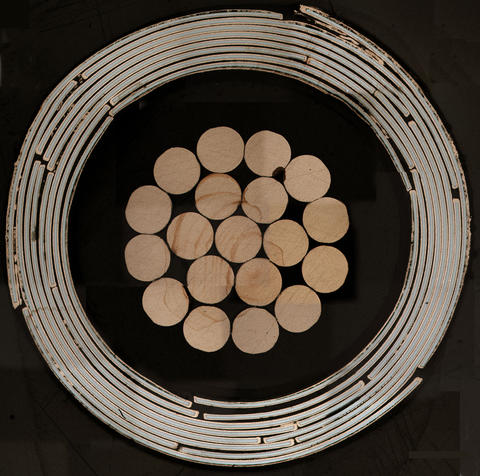
Cross-section of a high-temperature superconducting cable design invented at NIST. In the center are copper wires bundled with nylon and plastic insulation. The outer rings are a series of superconducting tapes wrapped in spirals around the copper. The cable is 7.5 millimeters in outer diameter.
A method developed by researchers at the National Institute of Standards and Technology (NIST) and the University of Colorado at Boulder for making thin, flexible, high-temperature superconducting (HTS) cables has won a 2011 R&D 100 Award from R&D Magazine. The prestigious annual awards salute the 100 most technologically significant products introduced into the marketplace over the past year.
Designed to operate at -196° C (-353° F), the new superconducting cable has a diameter of less than 1 centimeter and is able to carry 2,800 amperes of current—three times as much as thicker, conventional copper or aluminum electrical transmission lines.
The cables are constructed by winding multiple HTS-coated conductors around a multi-strand copper core. The superconducting layers are wound in spirals in alternating directions.
According to developer Danko van der Laan, a University of Colorado scientist working at NIST, the main innovation in the compact cables is the tolerance of newer HTS conductors to compressive strain that allows use of the unusually slender copper core.
Besides power transmission, cables constructed using this invention could be used for superconducting transformers, generators and magnetic energy storage devices that require high-current windings. The compact cables also could be used in high-field magnets for fusion and high-energy physics research and for medical applications such as proton-accelerator cancer treatment systems and magnetic resonance imaging.
Winners of the R&D 100 Awards are selected by an independent panel and the editors of R&D Magazine. The winners represent a cross-section of industry, academia, private research firms and government labs. Winning technologies are used in medical, industrial, research, consumer and manufacturing applications.
To read more about the technology, see the Feb. 10, 2011 announcement, "Compact High-Temperature Superconducting Cables Demonstrated at NIST."
Read R&D 100 Award citation.
D.C. van der Laan, X.F. Lu and L.F. Goodrich, "Compact GdBa2Cu3O7-δ coated conductor cables for electric power transmission and magnet applications," Superconductor Science & Technology, vol. 24, 042001, April 2011. doi: 10.1088/0953-2048/24/4/042001. http://iopscience.iop.org/0953-2048/24/4/042001.

